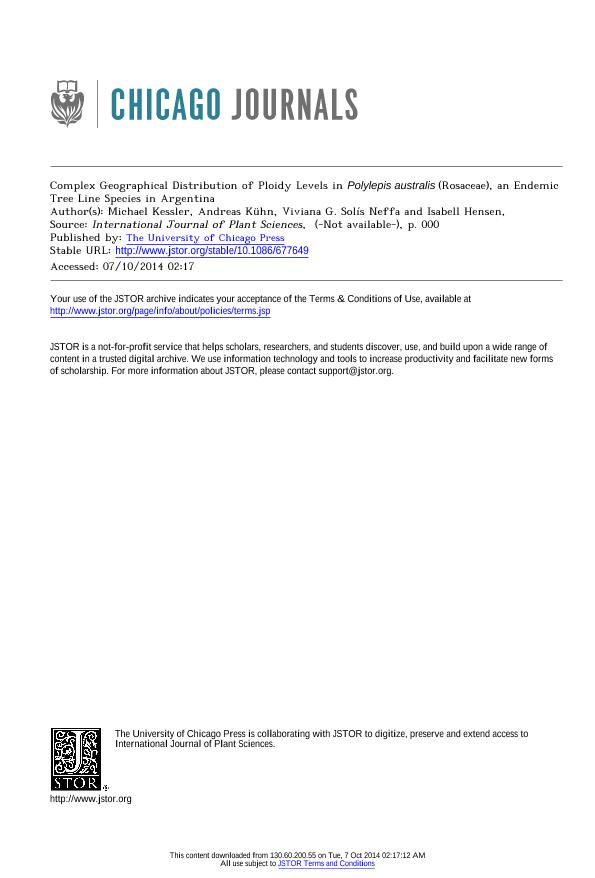Mostrar el registro sencillo del ítem
dc.contributor.author
Kessler, Michael
dc.contributor.author
Kühn, Andreas
dc.contributor.author
Solis Neffa, Viviana Griselda

dc.contributor.author
Hensen, Isabell
dc.date.available
2017-07-06T17:24:05Z
dc.date.issued
2014-09
dc.identifier.citation
Kessler, Michael; Kühn, Andreas; Solis Neffa, Viviana Griselda; Hensen, Isabell; Complex Geographical Distribution of Ploidy Levels in Polylepis australis (Rosaceae), an Endemic Tree Line Species in Argentina; Univ Chicago Press; International Journal Of Plant Sciences; 175; 8; 9-2014; 955-961
dc.identifier.issn
1058-5893
dc.identifier.uri
http://hdl.handle.net/11336/19737
dc.description.abstract
Premise of research. The geographical distribution of ploidy levels provides insights into evolutionary pathways. For the subtropical tree line species Polylepis australis (Rosaceae), we tested the hypotheses that (1a) incidence of polyploidy is higher in the northern parts than in the southern parts of the species range due to the presence of related species that might favor hybridization (allopolyploidy), (1b) incidence of polyploidy is higher in the southern part of the range because the species here presumably reaches the limit of its environmental tolerance (autopolyploidy), and (2) ploidy levels increase with elevation, as polyploids are believed to perform better in stressful environments. Methodology. We used flow cytometry to assess the ploidy levels of 361 individuals from 27 populations across most of the distribution range of the species in two disjunct Argentinean high mountain regions. Pivotal results. The northern stands had lower ploidy levels (diploid) than the southern populations, in which we found mainly tetraploids intermixed with diploids, triploids, and a single hexaploid. We did not find any environmental correlates to the geographical distribution of ploidy levels. Conclusions. Polyploidy appears to have arisen in P. australis via autopolyploidy, either twice in different parts of the range or, more likely, once followed by long-distance dispersal. This is also supported by amplified fragment length polymorphism (AFLP) data from a previous study that confirmed higher numbers of AFLP fragments and private bands in the southern populations. The checkerboard distribution of ploidy levels in the southern Sierras de Co´ rdoba may represent a time capture of the spread of the polyploid condition. We propose that polyploidy represents a key factor to understanding the high morphological variation in P. australis and should be taken into account in ongoing reforestation activities.
dc.format
application/pdf
dc.language.iso
eng
dc.publisher
Univ Chicago Press

dc.rights
info:eu-repo/semantics/openAccess
dc.rights.uri
https://creativecommons.org/licenses/by-nc-sa/2.5/ar/
dc.subject
Andes
dc.subject
Autopolyploidy
dc.subject
Polylepis
dc.subject
Rosaceae
dc.subject.classification
Genética y Herencia

dc.subject.classification
Ciencias Biológicas

dc.subject.classification
CIENCIAS NATURALES Y EXACTAS

dc.title
Complex Geographical Distribution of Ploidy Levels in Polylepis australis (Rosaceae), an Endemic Tree Line Species in Argentina
dc.type
info:eu-repo/semantics/article
dc.type
info:ar-repo/semantics/artículo
dc.type
info:eu-repo/semantics/publishedVersion
dc.date.updated
2015-11-03T15:20:09Z
dc.identifier.eissn
1537-5315
dc.journal.volume
175
dc.journal.number
8
dc.journal.pagination
955-961
dc.journal.pais
Estados Unidos

dc.journal.ciudad
Chicago
dc.description.fil
Fil: Kessler, Michael. University of Zurich; Suiza
dc.description.fil
Fil: Kühn, Andreas. Martin-Luther-University Halle-Wittenberg; Alemania
dc.description.fil
Fil: Solis Neffa, Viviana Griselda. Consejo Nacional de Investigaciones Científicas y Técnicas. Centro Científico Tecnológico Nordeste. Instituto de Botánica del Nordeste (i); Argentina
dc.description.fil
Fil: Hensen, Isabell. German Centre for Integrative Biodiversity Research; Alemania
dc.journal.title
International Journal Of Plant Sciences

dc.relation.alternativeid
info:eu-repo/semantics/altIdentifier/doi/http://dx.doi.org/10.1086/677649
dc.relation.alternativeid
info:eu-repo/semantics/altIdentifier/url/http://www.journals.uchicago.edu/doi/10.1086/677649
Archivos asociados
